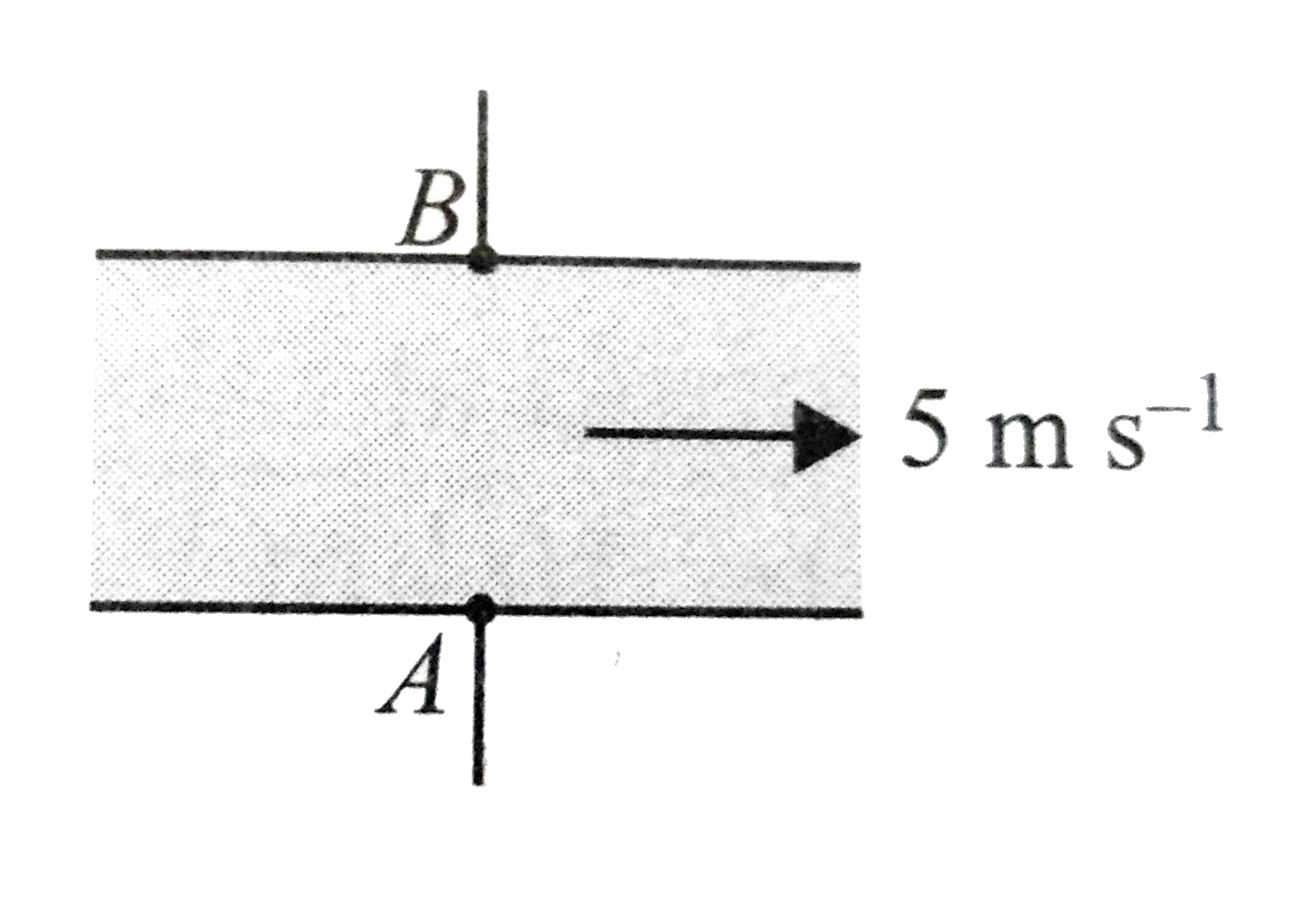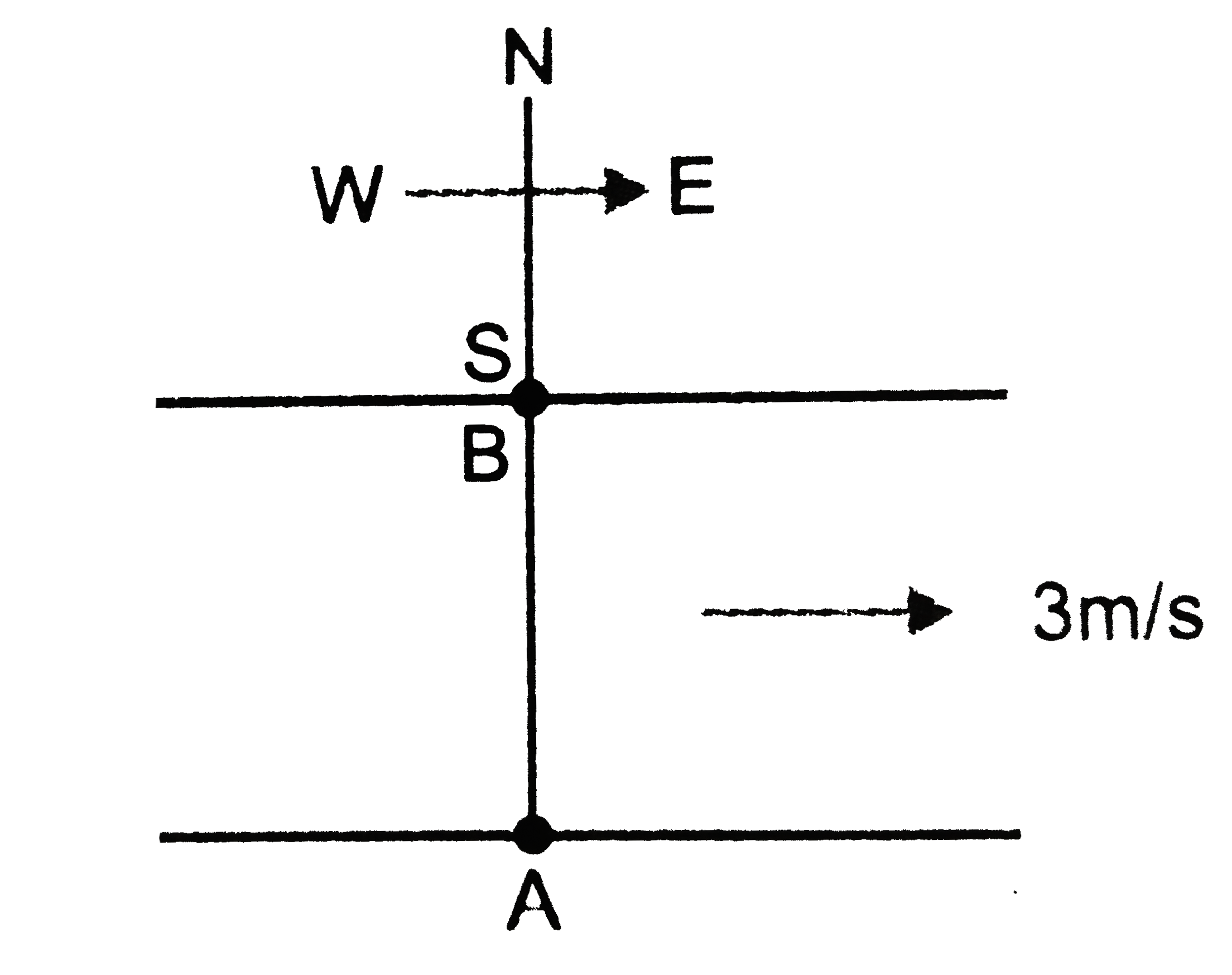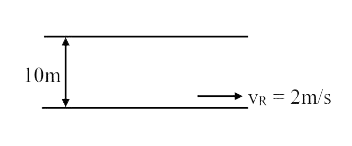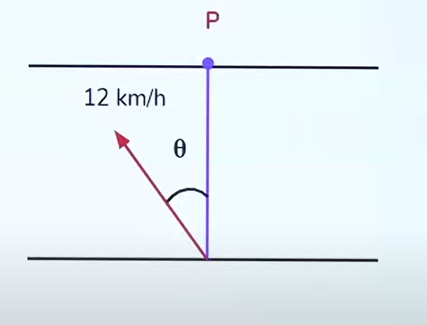A river is flowing from west to east with a speed 5 m s−1. A swimmer can swim in still water at a speed of 10 m s−1 .
If he wants to start from point A on south bank and reach opposite point B on north bank. In what direction direction should he swim ?

30∘ east of north
60∘ east of north
30∘ west of north
60∘ west of north
The correct Answer is:C

Here, Velocity of swimmer in still water, vs=10ms−1
Velocity of water flowing in river, →vr=5ms−1
from figure, sinθ=vrvs=510=12
θ=sin−1(12)=30∘ west of north
Topper's Solved these Questions
- MOTION IN A PLANE BOOK - NCERT FINGERTIPSCHAPTER - MOTION IN A PLANE EXERCISE - Projectile Motion
29 Videos
- MOTION IN A PLANE BOOK - NCERT FINGERTIPSCHAPTER - MOTION IN A PLANE EXERCISE - Uniform Circular Motion
14 Videos
- MOTION IN A PLANE BOOK - NCERT FINGERTIPSCHAPTER - MOTION IN A PLANE EXERCISE - Motion In A Plane With A Constant Acceleration
2 Videos
- MECHANICAL PROPERTIES OF SOLIDSBOOK - NCERT FINGERTIPSCHAPTER - MECHANICAL PROPERTIES OF SOLIDSEXERCISE - Assertion And Reason
15 Videos
- MOTION IN A STRAIGHT LINEBOOK - NCERT FINGERTIPSCHAPTER - MOTION IN A STRAIGHT LINEEXERCISE - Assertion And Reason
15 Videos
Similar Questions
A river is flowing due east with a speed 3m/s (Fig. 2 (EP) .31 ).
 . (a) If swimmer starts swimming due borth, what will be his resultant velocity (magnitude and direction) ? (b) If he wants to start from point (A) on South bank and reach opposite point (B) on North bank,
. (a) If swimmer starts swimming due borth, what will be his resultant velocity (magnitude and direction) ? (b) If he wants to start from point (A) on South bank and reach opposite point (B) on North bank,
(i) Which direction should he swim? (ii) What will be his resultant speed ? (c ) From two differenrent casses as mentioned in (a) and 9b) above, in which casse will he reach opposite bank in shorter time ?
View SolutionA swimmer can swim in still water with a speed of 2.5 m/s. What is the shortest time taken by him to swim across the river?

View Solution
Knowledge Check
A river is flowing due east with a speed 3ms−1. A swimmer can swim in still water at a speed of 4ms−1. If swimmer starts swimming due north, then the resultant velocity of the swimmer is
A3ms−1B5ms−1C7ms−1D2ms−1A man can swim in still water with a speed of 2ms−1. If he wants to cross a river of water current speed √3ms−1 along the shortest possible path, then in which direction should he swim ?
AAt an angle 120∘ to the water current.BAt an angle 150∘ to the water current.CAt an angle 90∘ to the water current.DNone of theseA river is flowing due east with a speed 3m/s. A wimmer can swim in still water at a speed of 4m/s. If swimmer starts swimming due north, what will be his resultant velocity (magnitude and direction) ?
 A5m/s at 37∘ to NB5m/s at 53∘ to NC10m/s at 37∘ to NDNone of these
A5m/s at 37∘ to NB5m/s at 53∘ to NC10m/s at 37∘ to NDNone of these
A swimmer can swim with speed 12 m/s in still water. Speed of river is 6 m/s. Find angle at which he should swim with downstream so that he reaches directly opposite point on other side

View SolutionA river is flowing from west to east with a speed of 5m/min. A man can swim in still water with a velocity 10m/min. In which direction should the man swim so as to take the shortest possible path to go to the south.
View SolutionAriver is flowing from west to east at a speed of 5 m/s. Aman on the south bank of the river capable of swimming at 10 m/s in a still water wants to swim, across the river in a shortest time He should swim in a direction
View SolutionA river is flowing from west to east at a speed of 5 metres per minute.A man on the south bank of the river, capable of swimming at 10 metres per minute in still water, wants to swim across the river in the shortest time. He should swim in a direction.
View SolutionA river is flowing from east to west at a speed of 5m/min. A man on south bank of river, capable of swimming 10m/min in still water, wants to swim across the river in shortest time. He should swim
View Solution
